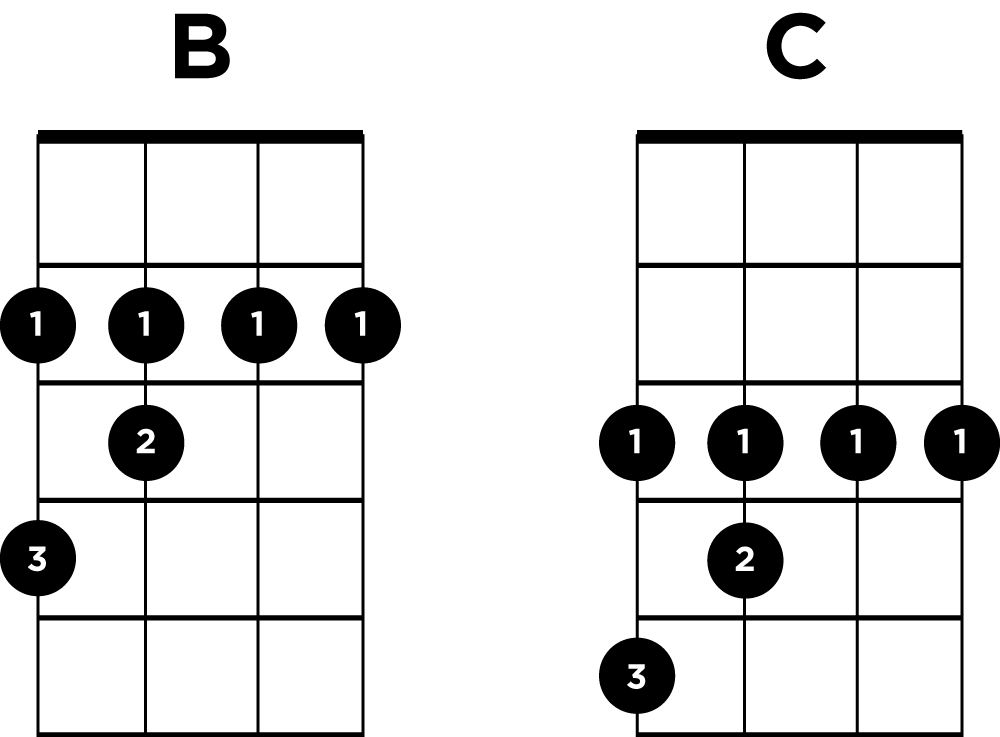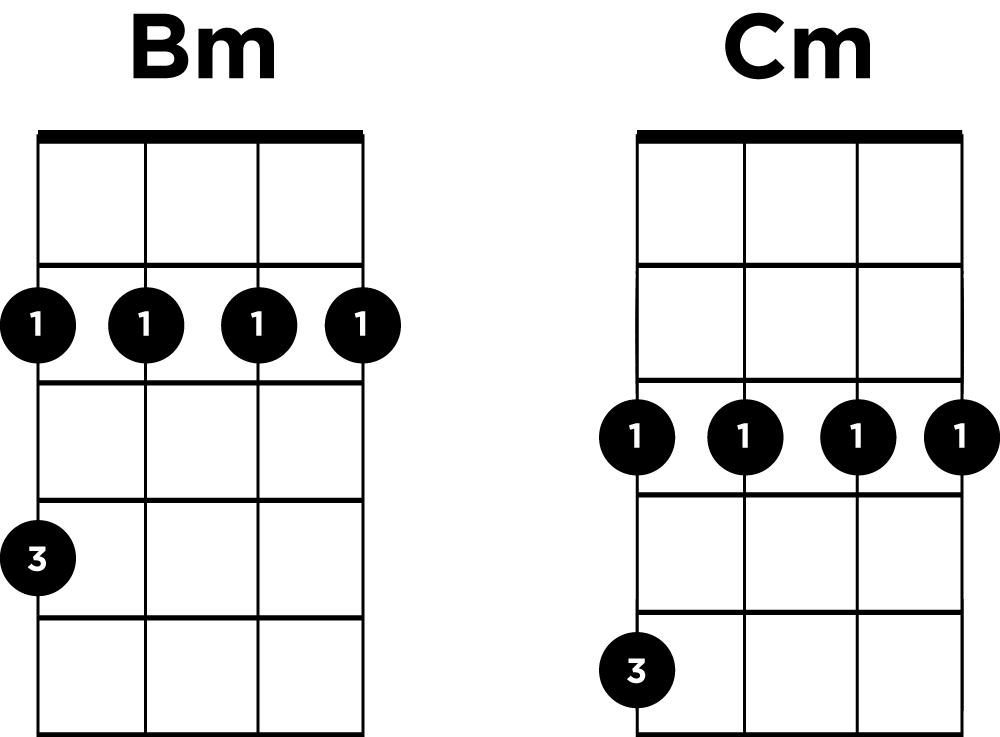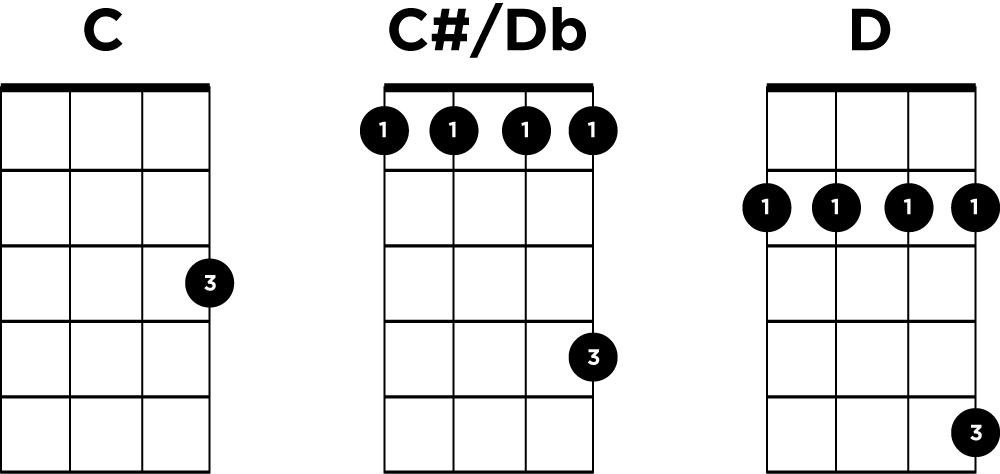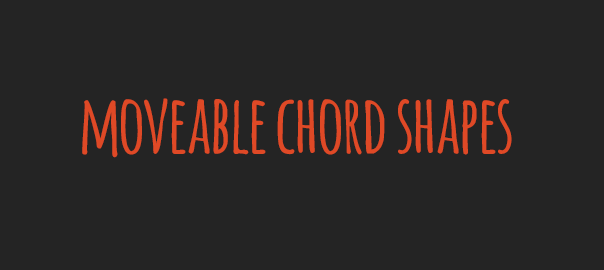It isn’t always about learning loads of different chord shapes. You can play just a few different chord shapes and have access to a huge amount of chords. Not only that, but by learning a few moveable chord shapes you’ll never struggle to remember a chord again.
The Chromatic Scale
One of the first things you need to know is the notes of the chromatic scale. Those notes are as follows…
| A | A#/Bb | B | C | C#/Db | D | D#/Eb | E | F | F#/Gb | G | G#/Ab |
|---|
Just take a look at that for a minute. You’ll see a sharp (#) or flat (b) between each note with the exception of between B to C, and E to F.
How Does This Relate To A Ukulele
You’ll be pleased to know that these notes relate directly to your ukulele. Each fret of your ukulele represents a note. Moving up and down those frets is exactly like counting up and down the chromatic scale.
Let’s take a C note for example. 3rd fret of your A (bottom) string. If we slide our finger up one ret to the 4th fret we just need to count up one in the chromatic scale to get the note name. Looking at the table above, that gives us a C#/Db.
For now that’s all you need to know, those notes relate directly to your ukulele frets.
Movable Chord Shapes
So we know that we can slide a note around our ukulele fretboard and quickly work out what note it is. What’s to stop us sliding a whole chord up or down? Nothing.
As an example I’m going to take a B chord. Note the form of this B chord doesn’t leave any open strings, that’s important.

If we take that B chord and slide the whole thing up a fret, that gives us a C chord (there’s no sharp or flat between a B & C remember). If we slide it up another 2 frets, we’ve got a D chord. Just by sliding one chord shape around we’ve now got 3 chords at our disposal. Handy.
Now let’s get back to our B chord again, but this time we’ll take off our second finger. This gives us a B minor. Slide the B minor shape up one fret and you’ve now got a C minor.

Hopefully this is starting to make sense to you now. You’ll be pleased to know that this applies to most chord shapes (technically it applies to all of them, but some need a little tweaking).
Let’s take a look at one of those that needs a little tweaking. The good old fashioned C chord.
The open C chord has 3 open strings. You only need to fret one string. This means we can’t simply slide one finger up and strum all the strings. What we need to do is account for those open strings. If we want to slide our whole C chord up 1 fret, we need to make a bar with our first finger.

Have a look at the diagrams above. Notice the addition of the first finger across the first fret for the C#/Db and then slid up another fret to make the D chord.
Extra Chord Knowledge
You can quickly see that just by sliding a chord around (and making the necessary adjustments for open chords) it changes the chord that you’re playing. You don’t necessarily need to know how to fret every single chord by memory.
In a future post I’ll elaborate on this further. Any questions, feel free to drop them in the comments!





Any info on resonator ukuleles would be nice
I really enjoy your site and appreciate your descriptions throughout your lessons. Thank you.
It may be easier to remember but it is MUCH harder to play. I find it so difficult to barre the first finger & play the others & still get much sound. I’ve tried to use 3 fingers on one fret instead but it doesn’t work as you go up the frets.
Practice. The more you do it the easier it will get. Believe it or not your fingers will get stronger. The action may be higher as you go up the frets so get someone to check it for you.
There’s a great barre chord exercise on you by a bloke called ukulele mike basically start somewhere towards the middle of the fret board where strings have an easier action get that done then try moving up and getting that very gradually as part of your practice this exercise builds strength to make it possible to get the top of the fret board mine still bit dodgy at times but it does help loads. Good luck
I meant YouTube by the way !!!
Hi Ive been playing for a couple of years. Im left handed and play my ukulele upside down. Playing barre chords is a whole lot easier but Im learning to reverse my strum
do you pick with the left hand?
from a left-handed beginner.
I took my uke to the music store where I bought it and they lowered the action a little bit. Best of all they did it for free. The action was just a little high and it made it difficult to try these chords. I still practice them and my fingers are getting better. Good luck.
That’s a great music store you have – really nice of them to do that
I did the same, had my action lowered a little and it’s much easier to make the chords.
yes I pick with my left hand. I rest my small finger on the uke and assign a finger to each string to finger pick songs
what about going over the other chord movable shapes like you have this one. This is very clear compared to most; very simple explained and useful. How about G, E, G7, etc?
Hey Randy, yeah I definitely plan on expanding this to include the other moveable chord shapes. Thanks for the feedback.
Brilliant tutorial Dave. As a relative newbie to the uke I was trapped within the bottom 5 frets and couldn’t quite work out how to play higher up the neck. I look forward to any follow-ups you may do in the future on this subject. Thanks enormously, you’re an ace tutor.
Is this info available for baritone uke?
J. Just learn right handed. It’s awkward to learn a stringed instrument as it is. If you learn to play right handed, you can go to any music shop and jam. Sincerely, a lefty
Can I just use a capo?
Hi Bob, you could use a capo but you’d be missing out.